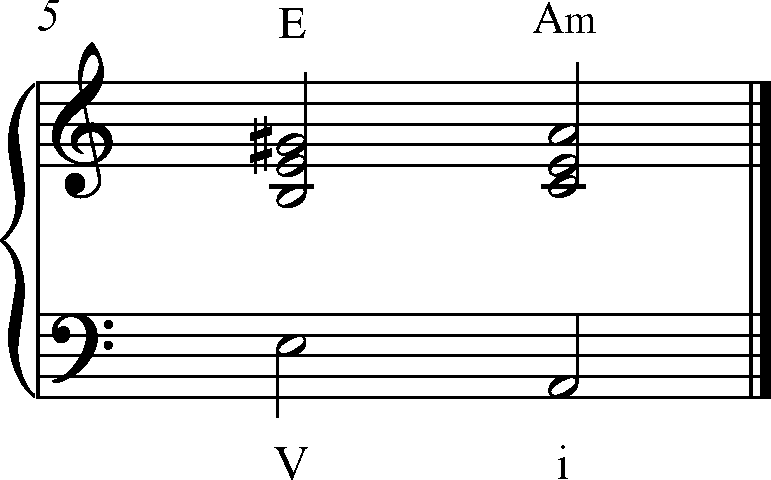B1 | Forms of the minor scale
The minor scale is a row of notes between one tonic and another. [Major and minor scales were discussed in A1 and A9.]
The technical names for each degree of the scale are the same for both major and minor keys (tonic, supertonic etc). In contrast to the major scale, the minor scale uses accidentals to alter some of the notes by raising them by a semi-tone or lower by a semi-tone. There are two kinds of minor scale:
- Harmonic minor scale
- Melodic minor scale which itself has two versions:
- Ascending
- Descending
Fig. 1
A harmonic minor scale

A melodic minor ascending scale

A melodic minor descending scale

When using these accidentals, the pattern of intervals in the minor scale is different to that of the major scale.
- Harmonic scale: T-HT-T-T-HT-aug 2nd -HT
- Melodic scale:
- Ascending: T-HT-T-T-T-T-HT
- Descending: T-T-HT-T-T-HT-T
This effects the chords that are used to accompany the melody. Here are chords based on the A minor scale; the lower case Roman numerals indicate minor chords and upper case Roman numerals indicate major chords.
Diminished chords are found on the supertonic and leading note. If you do not alter top note in the triad by raising it by a semi-tone, chord ii is diminished. Consider which one best suits your composition.
- Diminished supertonic (in A minor) B-D-F
- Minor supertonic (in A minor) B-D-F#
Similarly, if you do not raise the leading note, chord VII becomes a major chord. Look below to see how this affects the tonality of the chords.
Fig. 2

Notice that using accidentals effects the tonality of the chord. E-G-B (chord of the dominant) is a minor chord, but with G# it becomes a major chord. Usually, it’s the major chord of the dominant which is used in V–i cadences.
Chord:
An augmented interval is greater than a major interval by a semi-tone.
The interval between F natural and G# in A minor is an augmented 2nd.
A new interval that stems from the minor key is the diminished 7th. It can be heard as the melody leaps down from the sub-mediant to the leading note.
Using scales
In terms of the melody, the composer can choose either the notes that belong naturally to the minor key or alter them by employing accidentals, according to personal preference.
When composing in the minor key, you must decide on the shape of the melody. If you’re composing for voice, remember that certain intervals are easier to sing than others. It’s your choice when deciding which accidentals and leaps to use so that you create a melody that sounds effective.
Exercises
Exercise 1
Formulate a minor scale which begins on G and keep to pattern of intervals of your choice (harmonic or melodic). Then start on C, F etc.
Exercise 2
Click on the link below.
Add notes to the melody of Llam y Cariadau [‘Lovers’ Leap’] by R S Hughes in order to create phrases that show the same characteristics that could be in the original melody. Try adding chords to the melody. Then listen to the complete melody in its original version.
Composition task
Composing a melody in the minor key
1. How to decide on the notes in the melody?
- Go to an instrument or use your voice to create a short figure with few notes.
- Try to extend the idea to create a complete melody.
- Decide whether the notes in your melody flow smoothly from one to another.
- Consider which chords to add to the melody.
